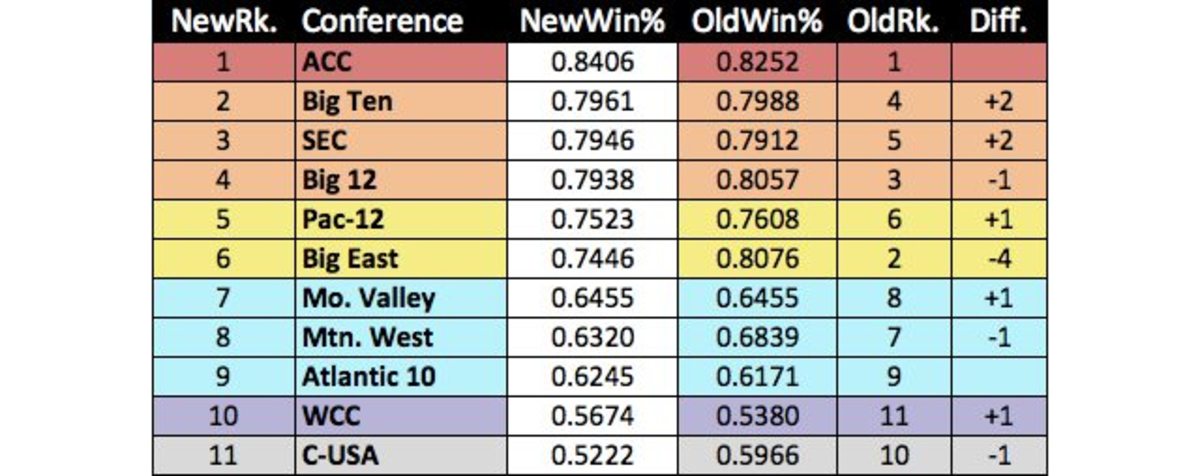By The Numbers: Big East suffers big hit in latest conference jostling
This week, in the brief calm between Notre Dame's departure from the Big East and Jim Calhoun's retirement, this quote, purportedly from a sky-is-not-falling interview given by new Big East commissioner Mike Aresco, appeared in my Twitter feed:
"We're still the strongest top-to-bottom basketball conference in the country."
After snickering, then checking the quote's provenance (Aresco really did make that claim), it was reasonable to deem this the lowest-hanging fruit of the basketball-realignment debate in 2012. An entire column is not required to debunk it. That can be done in one sentence: The strongest top-to-bottom conference is now the ACC.
But that leaves the question of where the Big East actually stands, as it's set to lose Notre Dame, Pittsburgh, Syracuse and West Virginia -- four reliably competitive basketball programs -- and replace them with Central Florida, Houston, Memphis, SMU and Temple. How much of a hit will the league take, and how strong is it in context of the other major conferences?
In a story in May, I proposed a method of quantifying top-to-bottom conference strength, post-realignment. Because the pecking order of leagues tends to be cyclical, I used kenpom.com's pythagorean winning percentages -- which are based on efficiency, the best measure of team quality -- for each conference's teams from the past 10 seasons. The first step was to rank conferences based on their actual memberships from 2003-2012, and this was the order of the big six:
1. ACC. 2. Big East. 3. Big 12. 4. Big Ten. 5. SEC. 6. Pac-12.
Six of the 10 national titles during that period came from the top two conferences -- the ACC and Big East. They were the most consistently strong leagues of the past decade. That's not up for debate.
But what happened when I went back and played out 2003-12 as if all the teams had already been re-aligned, with Notre Dame, Pitt and Syracuse in the ACC, West Virginia in the Big 12, Nebraska in the Big Ten, all the newcomers in the Big East, and so on? The landscape changed drastically. This graphic reveals the new pecking order:
The landscape isn't just divided between majors and mid-majors. Distinct tiers emerged within the majors. The ACC is alone in the penthouse, with an embarrassment of basketball riches. The Big Ten, SEC and Big 12 are closely grouped in Tier 2. Their status as power conferences is secure.
Then there's a third tier, with the Pac-12, which added a couple of mediocre teams but most importantly didn't lose any of its core ... and the Big East, which was pillaged of much of its core. They are in what amounts to a "mid-power" bracket, just below the elites but still well above the best mid-major conferences (the Missouri Valley, Mountain West and Atlantic 10).
You may not be sold on this as the end-all method of assessing conference strength -- I've seen less-scientific formulas that factor in NCAA tournament wins, titles and even NBA players produced -- but it's the best one I could devise. It removes the influence of coastal or brand bias, and ranks leagues using the most telling data available. And what it says is that realignment has made the Big East the weakest top-to-bottom major conference, not the strongest.
Of the 11 leagues I analyzed, only Conference USA suffered more in recent realignment than the Big East. I assessed C-USA only from 2006-onward, because it wasn't fair to include data from its halcyon days with Louisville, Cincinnati and Marquette; even so, the projected drop-off once it loses kingpin Memphis as well as Houston, Central Florida and SMU is immense.
The graphic below shows each conference's change in Pythagorean winning percentage, between the quality of its actual membership and the quality of its realigned membership, from 2003-12. (The most-improved leagues are on the left, the most-damaged are on the right.)
Realignment was not done in college basketball's best interests, and -- surprise, surprise -- realignment will hurt college basketball. Only four of the 11 conferences made marginal gains, one (the Missouri Valley) stayed the same and six were weakened. There's far more red than green on the chart.
Quietly, the most-improved league is the West Coast Conference, which jumped ahead of C-USA to No. 10 overall by adding BYU and Pacific to an already strong core of Gonzaga and St. Mary's. BYU, which is independent in football, may not stay in the WCC forever. But as long as it does, the league will have a case for multiple NCAA tournament bids.
The Big East, meanwhile, is unlikely to keep receiving hauls of nine NCAA bids like it did in 2012. It can't afford to lose another one of its hoops powers, yet there remains the chance that Louisville, Georgetown or UConn could be poached by a league with more stability (and more money). An optimist might say that the Big East's weaker new additions, such as SMU, Houston and Central Florida, will increase basketball spending enough to get more competitive and close the gap. But four perennial tournament teams are leaving and a Hall-of-Fame coach has retired; there is no quick way to fill that void.
Aresco was smart, last week, to quash any talk of changing the name of the Big East to something more geographically appropriate. He said there was too much brand equity built up in the Big East name. There was no sense in throwing that away. His job now -- and it seems like an impossible one -- is to prevent the brand's imminent erosion.






